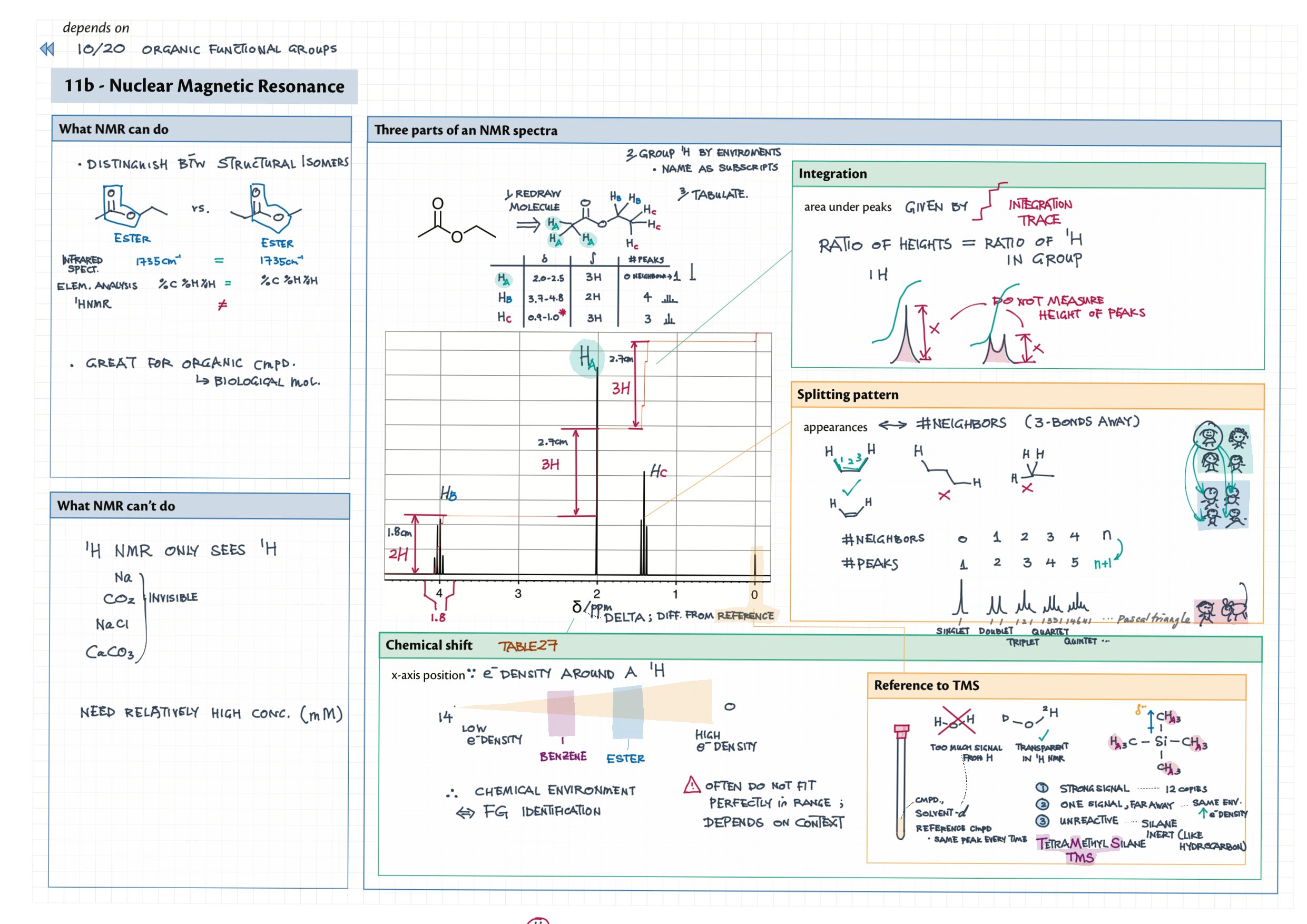# 11B / 21 Spectroscopy of Organic Compounds

11.3.NoS1
Improvements in instrumentation—mass spectrometry, proton nuclear magnetic resonance and infrared spectroscopy have made identification and structural determination of compounds routine. (1.8)
11.3.NoS2
Models are developed to explain certain phenomena that may not be observable—for example, spectra are based on the bond vibration model. (1.10)
11.3.U1
The degree of unsaturation or index of hydrogen deficiency (IHD) can be used to determine from a molecular formula the number of rings or multiple bonds in a molecule.
11.3.U2
Mass spectrometry (MS), proton nuclear magnetic resonance spectroscopy (1HNMR) and infrared spectroscopy (IR) are techniques that can be used to help identify compounds and to determine their structure.
11.3.AS1
Determination of the IHD from a molecular formula.
11.3.AS2
Deduction of information about the structural features of a compound from percentage composition data, MS, 1H NMR or IR.
11.3.G1
The electromagnetic spectrum (EMS) is given in the data booklet in section 3. The regions employed for each technique should be understood.
11.3.G2
The operating principles are not required for any of these methods.
11.3.G3
The data booklet contains characteristic ranges for IR absorptions (section 26), 1H NMR data (section 27) and specific MS fragments (section 28). For 1H NMR, only the ability to deduce the number of different hydrogen (proton) environments and the relative numbers of hydrogen atoms in each environment is required. Integration traces should be covered but splitting patterns are not required.
11.3.IM1
Monitoring and analysis of toxins and xenobiotics in the environment is a continuous endeavour that involves collaboration between scientists in different countries.
11.3.ToK1
Electromagnetic waves can transmit information beyond that of our sense perceptions. What are the limitations of sense perception as a way of knowing?
11.3.Uz1
IR spectroscopy is used in heat sensors and remote sensing in physics.
11.3.Uz2
Protons in water molecules within human cells can be detected by magnetic resonance imaging (MRI), giving a three-dimensional view of organs in the human body.
"
11.3.Aims1
Aim 7: Spectral databases could be used here.
11.3.Aims2
Aim 8: The effects of the various greenhouse gases depend on their abundance and their ability to absorb heat radiation.
21.1.NoS
Improvements in modern instrumentation—advances in spectroscopic techniques (IR, 1H NMR and MS) have resulted in detailed knowledge of the structure of compounds. (1.8)
21.1.U1
Structural identification of compounds involves several different analytical techniques including IR, 1H NMR and MS.
21.1.U2
In a high resolution 1H NMR spectrum, single peaks present in low resolution can split into further clusters of peaks.
21.1.U3
The structural technique of single crystal X-ray crystallography can be used to identify the bond lengths and bond angles of crystalline compounds.
21.1.AS1
Explanation of the use of tetramethylsilane (TMS) as the reference standard.
21.1.AS2
Deduction of the structure of a compound given information from a range of analytical characterization techniques (X-ray crystallography, IR, 1H NMR and MS).
21.1.G1
Students should be able to interpret the following from 1H NMR spectra: number of peaks, area under each peak, chemical shift and splitting patterns. Treatment of spin-spin coupling constants will not be assessed but students should be familiar with singlets, doublets, triplets and quartets.
21.1.G2
High resolution 1H NMR should be covered.
21.1.G3
The precise details of single crystal X-ray crystallography need not be known in detail, but students should be aware of the existence of this structural technique in the wider context of structural identification of both inorganic and organic compounds.
21.1.G4
The operating principles are not required for any of these methods.
21.1.IM1
The chemical community often shares chemical structural information on the international stage. The Cambridge Crystallographic Database, ChemSpider developed by the Royal Society of Chemistry and the Protein Data Bank (RCSB PDB) (at Brookhaven National Laboratory, USA) are examples which highlight the international nature of the scientific community.
21.1.ToK1
The intensity ratio of the lines in the high resolution NMR spectrum is given by the numbers in Pascals triangle, a mathematical pattern known independently over a thousand years ago by a number of different cultures. Why is mathematics such an effective tool in science? Is mathematics the science of patterns?
21.1.Uz1
Protons in water molecules within human cells can be detected by magnetic resonance imaging (MRI), giving a three-dimensional view of organs in the human body. Why is MRI replacing computerized tomography (CT) scans for some applications but is used as a complementary technique for others?
21.1.Uz2
MS (and other techniques such as TLC, GC, GC-MS and HPLC) can be used in forensic investigations at crime scenes.
21.1.Uz3
Analytical techniques can be used to test for drug abuse by high-performance athletes.
21.1.Aims1
Aim 7: Spectral databases can be used here.